Menus
- Massimo’s motorcycles
- Bimota HB1, HB2 and KB2 lasers
- Lowest seat heights, brutally sharp knee angles
- Origin of the hybrid frame
- Massimo Tamburini at Cagiva / Ducati
- "Cagiva was Ducati’s dairy cow for 12 years"
- Brutale has too many F4 genes
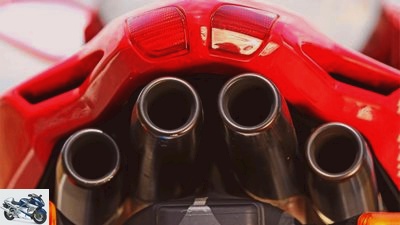
Jahn
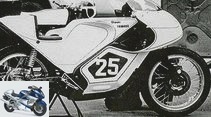
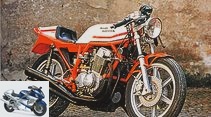
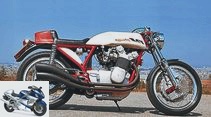

47 photos
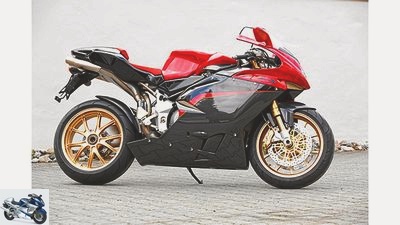
Pompe
1/47
2004: MV Agusta F4 1000 Tamburini.
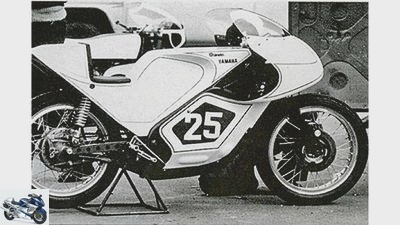
Bimota
2/47
1974: Bimota YB1 250-350.
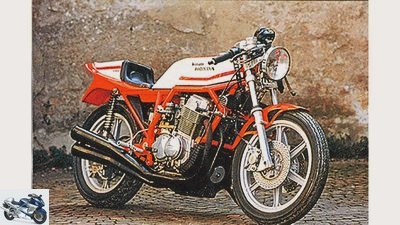
Bimota
3/47
1973: Bimota HB1 750.
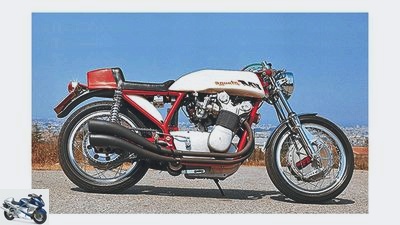
4/47
1971: MV Agusta 600 Four racing conversion.
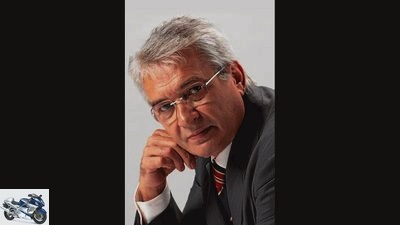
MV Agusta
5/47
The creator of these treasures, Massimo Tamburini, died of cancer on April 5th of this year at the age of 70. He founded Bimota in 1966 and later worked for Cagiva, Ducati and MV Agusta …

6/47
… In his honor, MV launched an F4 special model limited to 300 copies in 2004.

Pompe
7/47
… to this day, designers and technicians from other manufacturers orient themselves to their exciting design language.

Pompe
8/47
The typically shaped headlamp, for example, has been copied many times.
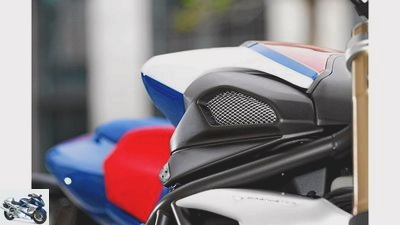
Pompe
9/47
Pure pleasure: With the Brutale, Tamburini proved that he can not only do athletes, but also naked bikes. The naked MV became a milestone similar to the F4, …
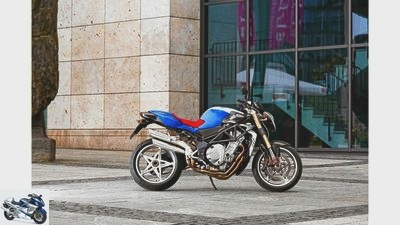
Pompe
10/47
MV Agusta Brutale America: water-cooled four-cylinder engine, 749 cm³, 93.4 kW (127 PS), max. Torque 77 Nm, tubular steel frame, wheelbase 1414 mm, weight with a full tank of 212 kg, price 2004: 14,950 euros plus “America” kit 2400 euros.
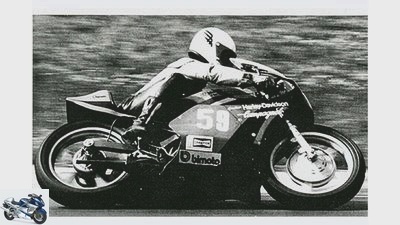
Bimota
11/47
1974: Bimota HD1 250.

Bimota
12/47
1975: Bimota HD 350.
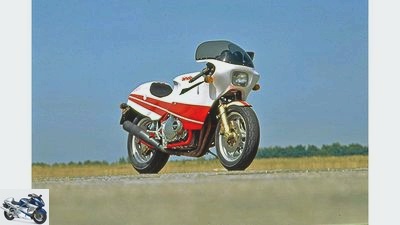
Schwab
13/47
1982: Bimota SB4 1100.

MV Agusta
14/47
2004: MV Agusta F4 1000 S..
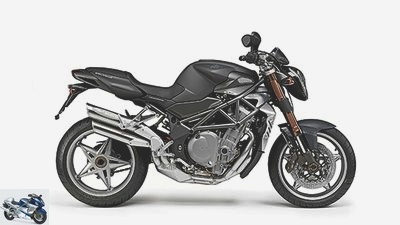
MV Agusta
15/47
2002: MV Agusta Brutale S..

Jahn
16/47
2000: MV Agusta F4 750 S..
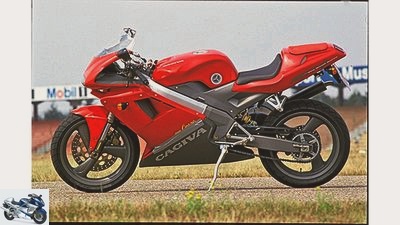
Schwab
17/47
1994: Cagiva Mito EV.
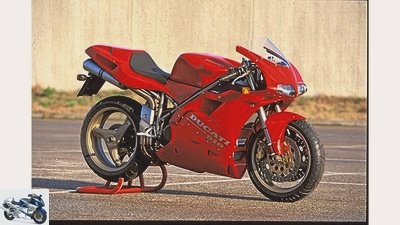
duke
18/47
1992: Ducati 916.
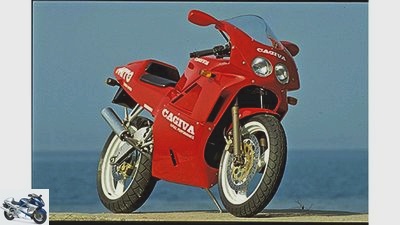
Schwab
19/47
1989/90: Cagiva Mito 125.
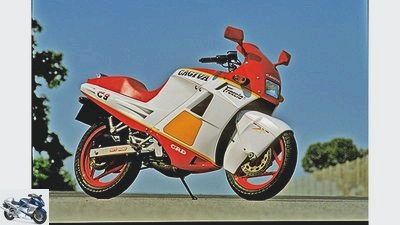
20/47
1987: Cagiva Freccia C9.
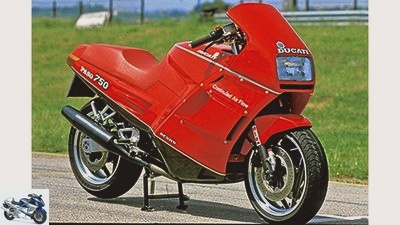
21/47
1986: Ducati Paso 750.
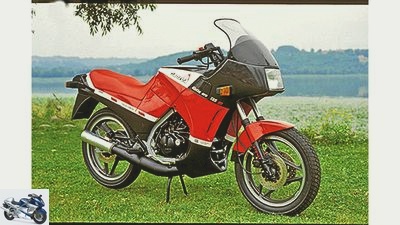
22/47
1985: Cagiva Aletta Oro 125.
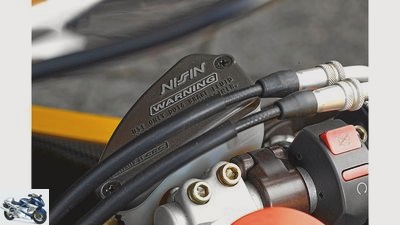
Pompe
23/47
… Radially arranged valves and cassette gears mean considerable effort in production. Even if the underseat exhaust is out today, it has never been more beautiful than on the F4.

Pompe
24/47
… Andrea Goggi designed the engine in collaboration with Ferrari, …
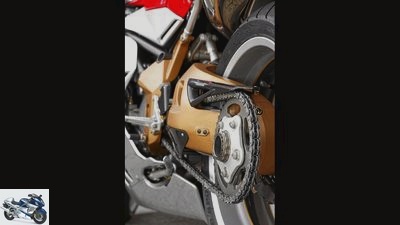
Pompe
25/47
The completion: perfect aesthetics down to the last detail and modern technology accumulated in the F4 …
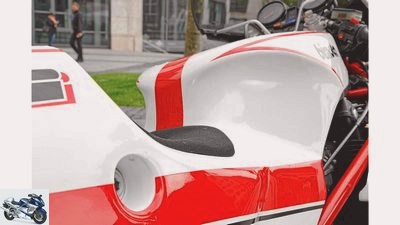
Pompe
26/47
Hybrid technology: The frame of the HB2, made of milled aluminum parts and high-strength steel tubes, was trend-setting and is still a modern design today. Otherwise the HB2 was way ahead of its time with its one-piece tank-seat combination, …
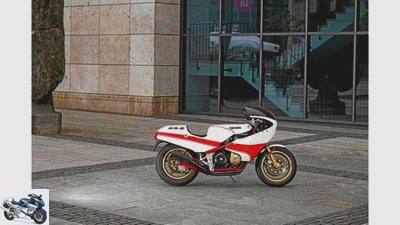
Pompe
27/47
Bimota HB2: air-cooled four-cylinder engine, 902 cm³, 70 kW (95 PS), max. Torque 79 Nm, double loop frame made of steel tubes, screwed to milled aluminum plates, wheelbase 1435 mm, weight with a full tank 229 kg, price 1982: 28,500 marks.

Pompe
28/47
Air-cooled four-cylinder engine, 593 cm³, 48 kW (65 PS), max. Torque 54 Nm, tubular steel frame, wheelbase 1370 mm, weight with a full tank of 188 kg, price 1982: 26,300 marks.

Pompe
29/47
The cylinder and head are freely accessible from above for repairs.
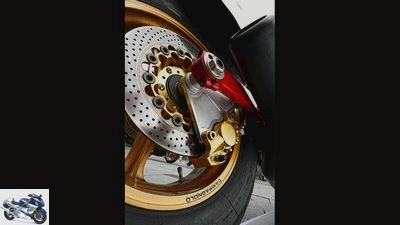
Pompe
30/47
The swing arm bearing is coaxial with the transmission output, but thanks to the narrow 550 four-cylinder engine, the frame was not too wide.
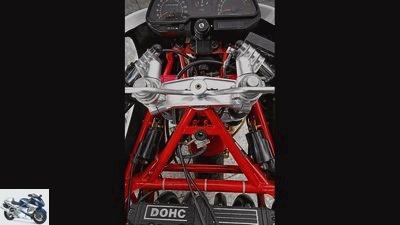
Pompe
31/47
… consisting of short, straight pipe sections that support the control head in three dimensions.

Pompe
32/47
Masterpiece: The KB2’s latticework is a true work of art, …
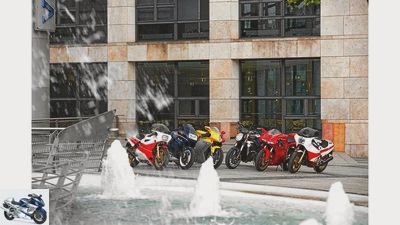
Pompe
33/47
The technician and designer Massimo Tamburini had a lasting influence on the development of motorcycle construction. As a souvenir, the editors assembled two machines from each era for a short trip and detailed consideration.
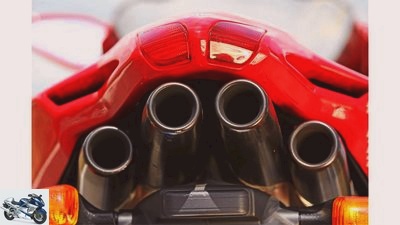
Jahn
34/47
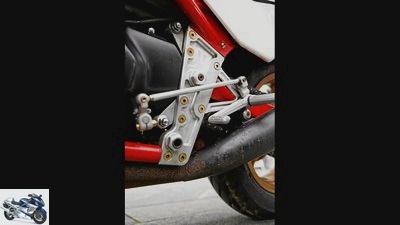
Pompe
35/47
… the central spring strut with progressive leverage and a Ceriani racing fork with front axle quick-release fasteners and adjustable damping on the bars at the top.

Pompe
36/47

Pompe
37/47
Thrown in shell: a tubular steel frame is hidden beneath the plastic cover that graciously covers everything. But it’s not nice, because in the case of the Paso it consists of square tubes.

Pompe
38/47
MV Agusta F4: water-cooled four-cylinder engine, 749 cm³, 93 kW (126 PS), max. Torque 74 Nm, tubular steel frame, wheelbase 1412 mm, weight with a full tank of 219 kg, price in 2000: 32,995 marks.
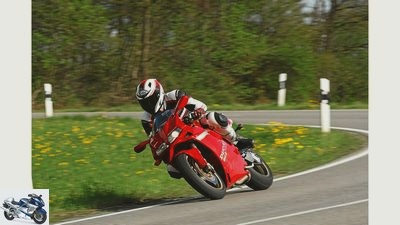
Pompe
39/47
… And of course with their typical dull V2-Bollern that makes every Panigale driver jealous.

Pompe
40/47
… It can still inspire today with its function-oriented design and groundbreaking detailed solutions …
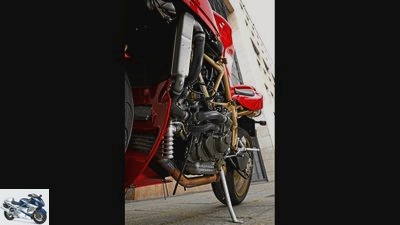
Pompe
41/47
… a sensation in terms of technology and aesthetics …
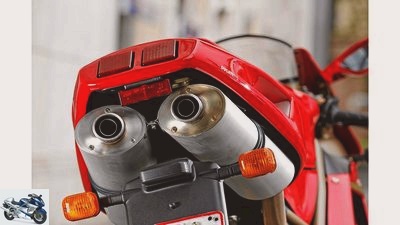
Pompe
42/47
Bella Macchina: Until then, technology has never been wrapped in a more beautiful way, the 916 was already an epoch-making motorcycle when it was presented in 1993, …
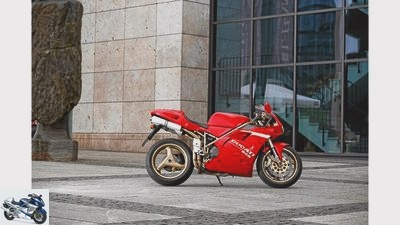
Pompe
43/47
Ducati 916: water-cooled two-cylinder 90-degree V-engine, 916 cm³, 79 kW (106 PS), max. Torque 86 Nm, tubular steel frame, wheelbase 1410 mm, weight with a full tank of 214 kg, 1994 price: 28,490 marks.
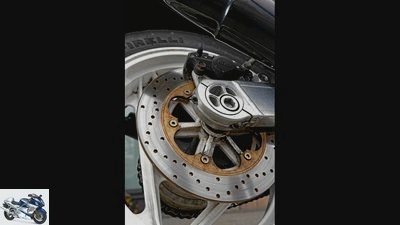
Pompe
44/47
… Pretty details like the eccentric can also be found on the later, water-cooled 906.
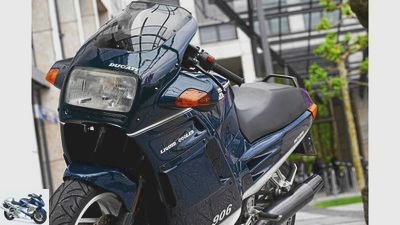
Pompe
45/47
Nevertheless, the Paso 750, the first machine of the Cagiva-Ducati group, formed the technical basis for modern Ducati athletes …
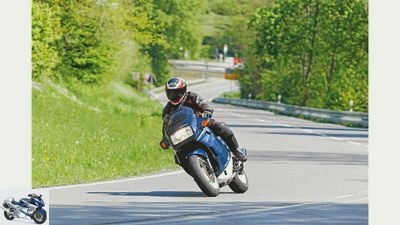
Pompe
46/47
Ducati Paso 906: Air-cooled two-cylinder 90-degree V-engine, 904 cm³, 65 kW (88 PS), max. Torque 84 Nm, double tubular steel frame, wheelbase 1453 mm, weight with a full tank of 222 kg, price 1989: 15,990 marks.
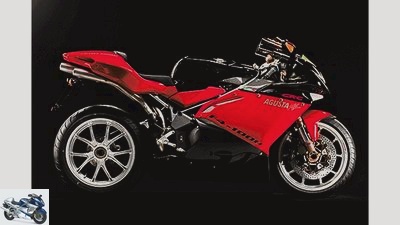
MV Agusta
47/47
2004: MV Agusta F4 1000 Mamba.
Ride on Tamburini bikes
Massimo’s motorcycles
MOTORRAD has a list, written by Massimo Tamburini, of the motorcycles he has developed. In memory of the great technician and designer, the editorial team gathered two machines from each era for a brief excursion and detailed consideration.
Massimo Tamburini overlooked the long lines of development in motorcycle construction and helped shape them in a sustainable way. His largest work, the Ducati 916, was a landmark for motorcycle designers that shone in red for more than a decade. He was also a detail-obsessed pedant who could look at a point for hours and not care about the long lines of development. who the D.Seeing the ucati 916 only as a design icon captures at most half of its personality and that of its designer. Because it is not only a diva, but also a well thought-out, neatly crafted, screwdriver-friendly motorcycle. Because of such mundane details as the logical structure of the cladding system to perfectly integrated plug connections in the right places.
Buy complete article
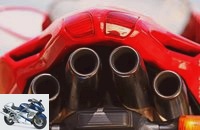
Ride on Tamburini bikes
Massimo’s motorcycles
MV Agusta F4 will show in this story. You probably do it justice best if you see its most powerful drive in the pursuit of the most perfect functionality possible, which after long, patient development work brings out external beauty. Anyone who makes the acquaintance of such a motorcycle as a driver, i.e. coming from outside, says sentences such as “A beautiful machine is also fast.” Massimo Tamburini would probably have put it the other way round.
Bimota HB1, HB2 and KB2 lasers
His beginnings as a motorcycle developer are clearly technically motivated. He converted a good 600 MV Agusta with cardan drive to chain drive and upgraded it to 750 cm³. He welded a stable chassis for the Honda CB 750, which had brought him down by high-speed commuting in the Quercia curve of the old Misano racetrack. The result was the first Bimota, the HB1, of which ten were built. This early phase of Tamburini’s work is represented here by the KB2 Laser and the second Honda Bimota, the HB2. Although both motorcycles were built just one year apart and look very similar at first glance, they stand for two different design philosophies: the strict principle and the more pragmatic one that allows compromises in order to save costs.
Although “only” equipped with 500 and 550 series engines from Kawasaki, the KB2 has the most elaborate chassis that Bimota has ever built. The frame itself consists exclusively of straight steel tubes in triangular connections; only the square profiles of the swing arm were bent in two swings each to encircle the gear on the outside and thus create a swing arm pivot point coaxial with the chain pinion.
Lowest seat heights, brutally sharp knee angles
The effort that Bimota put into the steering head section is extreme. It should be extremely torsion-resistant and at the same time provide sufficient steering angle, so the steering head is supported several times on all sides in the middle of a tubular structure that encloses the swivel area of triple clamps and fork bars and at the same time acts as a holder for the meticulously laminated fairing dome. The unconditional search for the optimum is the construction principle here.
In keeping with the fashion of the early 1980s, both Bimotas roll on wide 16-inch magnesium wheels from Campagnolo, making them very small, light and low. Despite the impressive handling-friendly chassis geometry with a short wheelbase and caster, they feel extremely stable when driving. However, the historical tire material prevented a review of the knowledge often formulated in the 1980s that Bimotas get better and better, the harder you run them on. That would suit Massimo Tamburini’s striving, the testers preferred to be content with careful rolling around. Even in doing so, the noble finish, the patina of 30 years with partly long downtimes, expressive exhaust roar and the amazement at the lowest seat heights with brutally sharp knee angles created a unique cocktail of sensory impressions.
Origin of the hybrid frame
In contrast to the KB2, the HB2, with the engine of the Honda CB 900 F Bol d’Or, allows for curved frame beams and a plain black sheet steel tank, which is of course hidden under an attractively painted GRP monocoque. The HB2 dispenses with the coaxial pivot point of the rocker arm and chain pinion, which keeps the chain tension constant with every compression and rebound movement of the rocker arm; otherwise it would have become too wide in the area of the swing arm mounting. Its frame is also an expression of a rational attitude and more efficient production in other respects: It could be adapted for several engine types with little effort. In addition to the HB2, the SB4, KB3 and HB3 also have it.
If you look closely, you will discover a construction element in this pipe mill that Massimo Tamburini brought to perfection in his late work, the MV Agusta F4. This refers to the area around the swing arm and the rear engine mounts, which are made of milled light metal plates, to which the steel tubes of the frame are attached. Today the light metal part is a stable cast box, but apart from that, the origin of the hybrid frame that characterizes the newer MV to this day lies in the chassis of the HB2.
Massimo Tamburini at Cagiva / Ducati
In 1983 Massimo Tamburini left the Bimota company, which he co-founded, and worked for a short time at Roberto Gallina, in whose 500 World Cup team Marco Lucchinelli and Franco Uncini became world champions. The next stretch of road led him to Cagiva. And because Cagiva founder Claudio Castiglioni took over the manufacturer Ducati, which was in dire financial difficulties, in 1985, the first large motorcycle that Tamburini designed for Cagiva / Ducati was the Paso 750. It appeared in 1986, the same year as the Honda CBR 600 models F and CBR 1000 F. This is astonishing because the largest motorcycle manufacturer in the world and a small niche manufacturer from Northern Italy came onto the market practically at the same time with aerodynamically optimized, fully wired machines. In terms of technology, the Hondas and the Ducati Paso differ fundamentally; they all share the basic idea of directing and using the air currents that flow around and through a moving motorcycle as efficiently as possible.
So it’s no wonder that the dark blue 906, the further development of the original Paso 750, still offers excellent wind protection, for which the driver has to duck so far that he can just look over the originally pane-free edge of the fairing dome. With the elaborate, air-assisted Marzocchi M1R fork and the lever system for the aluminum swingarm, the Paso has high-quality spring elements, and the frame made of steel square tubes would be good for far more power. Although the Paso cut a good figure on the racetrack and was initially seen as a sports machine by the MOTORRAD testers, it was intended more as an all-round machine. The super sporty Ducati 851, released in 1988, clearly assigned her this position.
The Paso brings a component to the driving experience with Tamburini creations that the maestro himself could not do: the sound. The beat of the 90-degree V2, which is modulated into a powerful bass-baritone by the slim, conically drawn silencers, is still fascinating today. In similar acoustic power, it forms the icing on the fascination of the 851, 888 and 916.
Pompe
The Paso 750, the first machine of the Cagiva-Ducati group, formed the technical basis for modern Ducati athletes.
Why was the 916 called Tambourini’s greatest work at the beginning of this story? Precisely because it unfolds such a beguiling sound alongside everything else. What does it mean that the 916 no longer offers enough power to crack something on the racetrack against the 600, that the old, heavy Desmoquattro chunk and the heavy three-spoke wheels give the steering properties a certain stubbornness? When the elaborate engine with roller-bearing camshafts ignites after an audible effort on the starter – before starting, please switch off the headlights and wait until the fuel pump has stopped running again – something in the driver’s head will also ignite. This is not just a memory of bygone times, the MOTORRAD editors were able to experience this again.
In addition to the immediate appeal, the 916 also sparked a wide range of memories: of a photo showing that Carl Fogarty accelerated out of the Sugo chicane at less than 3000 rpm, of a test in Hockenheim in which the 916 was on the same tires achieved higher cornering speeds on average than any other super sports car, on an ecstatic Nordschleife lap with light wheels and Michelin racing tires. And Massimo Tamburini himself, how he explained the development of the special quick-release fasteners of the 916 during a visit to the CRC in San Marino. He reached into his wallet, took out a conventional quick release fastener: “Do you notice? It feels disgusting and is ugly; it doesn’t fit between your fingers. I had to change that. ”In the meantime, both Ducati and MV Agusta have moved away from the hand-flattering quick-release fasteners for the F3 models, perhaps for cost reasons.
"Cagiva was Ducati’s dairy cow for 12 years"
In many details, the MV Agusta F4 embodies the further development and even refinement of the 916 in terms of ergonomics, its radicalization and the deliberate departure from the face of the 916 in the design of the front view. When he designed the F4, Claudio Castiglioni had financially and legally – his chief designer Tamburini probably also internally – concluded with the chapter Ducati. He felt that the famous Ducati brand had drawn too many resources away from the less reputable Cagiva brand. “Per dodici Anni Cagiva era la Mamma per Ducati.” As he meant and pronounced it, the term “Mamma” had nothing loving in this sentence. “For twelve years, Cagiva was Ducati’s milk cow,” is the correct translation. In order to commemorate the rebirth of MV Agusta, the F4 had to have the upright trapezoid headlight, the Nissin components specially designed for it, and the compact motor with the radially arranged valves and the backpack alternator. And, as I said, the hybrid frame. “There is another way and even better,” should be the message.
In the hand-built “Oro series” the cast parts of the frame and the swingarm were made of magnesium, the F4 shown here has been upgraded to the Oro standard with all of the tuning parts offered at the time. Leo Le Rose, its owner, wanted the motorcycle to be painted in yellow / silver, but Maestro Tamburini himself stood sideways. The quarrel, half in earnest and half in jest, ended with a very attractive compromise: everyone got a page with the paint they wanted. When driving, the F4 renewed its insight into a dilemma: It’s a shame about every kilometer off the racetrack. Because unlike the 916, it is only there that it can fully develop its radical sportiness. On the other hand, there is a high risk of throwing the treasure into the gravel. As it almost happened to the author while driving an F4 1000 Senna in Hockenheim. Euphoric, with unlimited confidence in their chassis qualities, he turned into the Motodrom far too quickly. The F4 began to slide gently but unmistakably over both wheels, and I completed the turn on the curbs without even applying the throttle. Because then the road would have run out. Since then, the F4 limit has been synonymous with the absolute limit for me.
Brutale has too many F4 genes
The Brutale may be less sporty, but it’s not a really comfortable motorcycle either. It has too many F4 genes for that, is too agile, and the engine, especially that of the early 750s, is too demanding. This also applies to the America special model, whose blue paintwork is reminiscent of the 750 S from the early 1970s. The 750s are what they are called. And it was only with the big 1078 engine that the Brutale found that powerful, smooth power delivery that, although contrary to their name, corresponds more to their status as a country road athlete. They have evolved with their Creator. Now they have to do it without him.
MOTORRAD thanks the owners of the Tamburini bikes: Leo Le Rose from Reutlingen, Michael Terlutter from Harsewinkel and Bernd Heilmayr from Kleinaspach.
Related articles
-
39 photos 1/39 The Triumph Speed Triple: The price 11,740 euros (the test motorcycle with windshield for 245 euros and…
-
Werel Motorcycles that fall out of the ordinary, part 2 Outstanding bikes from Kawasaki, Honda, Triumph and Harley-Davidson It is not easy in life when…
-
Comparison test of naked bikes from Italy
Artist 7th photos Ducati 1/7 Ducati Streetfighter / S Ducati 2/7 Ducati Streetfighter / S Ducati 3/7 Ducati Streetfighter / S Ducati 4/7 Ducati…
-
Comparison test of noble naked bikes
Artist Comparison test of noble naked bikes Ducati Streetfighter S and Bimota DB6R in comparison test Strong in sound, noble, self-confident. And with a…
-
Comparison test of mid-range bikes
Gargolov Comparison test of mid-range bikes Underdogs They show off neither engine capacity nor performance, they do without racing-style outfits and war…
-
Comparison test: seven enduro bikes in Sweden
Jahn 28 photos Jahn 1/28 The operation of the Multistrada has also changed: a control center for electronics and motor directly on the handlebars. Jahn…
-
Comparative test of naked bikes from Germany, Austria, USA, Great Britain
Artist 21st photos BMW 1/21 BMW 2/21 BMW 3/21 BMW 4/21 BMW 5/21 BMW 6/21 BMW 7/21 BMW 8/21 BMW 9/21 BMW 10/21 BMW 11/21 BMW 12/21 BMW 13/21 BMW 14/21 BMW…
-
Tambourini 16 photos Tambourini 1/16 Massimo Tamburini started the project himself in 2012. Tambourini 2/16 After the Italian passed away in April 2014,…
-
90 hp naked bikes in a comparison test
fact 27 photos fact 1/27 One look at the performance diagram and it becomes clear: Even within the 90 hp middle class, there are worlds between the…
-
Comparison test of single-cylinder city bikes: Honda SLR 650 and BMW F 650 ST
Comparison test of single-cylinder city bikes: Honda SLR 650 and BMW F 650 ST The funtastic two Honda SLR 650 and BMW F 650 ST have the same claim: to be…